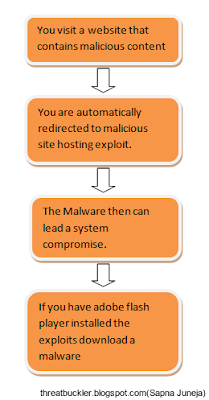Wednesday 14 October 2015
Threat Buckler: Another New Zero Day exploit Hits Adobe Flash Play...
Threat Buckler: Another New Zero Day exploit Hits Adobe Flash Play...: After so much efforts of Adobe Flash Player attackers find a way New Zero-Day exploit Hits Adobe Flash Player. Flash, attackers fro...
Another New Zero Day exploit Hits Adobe Flash Player Vulnerability
After so much efforts of Adobe Flash Player attackers find
a way New Zero-Day exploit Hits Adobe Flash Player. Flash, attackers
from the Pawn Storm cyber-espionage campaign are exploiting yet another new
zero-day in flash so they can surreptitiously install malware on victim
computer.

It is advised to uninstall or disable the adobe Flash Player
immediately before you will be in trap of hunter.
Fortunately, for the time being, this exploit is only
being used against Government agencies and several foreign affairs ministries
as part of a long-running espionage campaign carried out by a group known as
Pawn Storm.
“Based on researcher analysis, the Flash zero-day affects at
least Adobe Flash Player versions 19.0.0.185 and 19.0.0.207”.
Flash Zero Day Exploit Flow:

Trend Micro reported:
In this most recent campaign, Pawn Storm targeted several
foreign affairs ministries from around the globe. The targets received spear
phishing e-mails that contained links leading to the exploit. The emails and
URLs were crafted to appear like they lead to information about current events,
with the email subjects containing the following topics:
“Suicide car bomb targets NATO troop convoy Kabul”
“Syrian troops make gains as Putin defends air strikes”
“Israel launches airstrikes on targets in Gaza”
“Russia warns of response to reported US nuke buildup in
Turkey, Europe”
“US military reports 75 US-trained rebels return Syria”
It’s worth noting that the URLs hosting the new Flash
zero-day exploit are similar to the URLs seen in attacks that targeted North
Atlantic Treaty Organization (NATO) members and the White House in April this
year.
Patch Not Available For Latest Zero Day Exploit
As of now no patch available for these Latest Exploit even with latest up-to date installation.
Adobe is working on this latest Flaw to patch.
Till the time being please Uninstall or disable Adobe Flash Player for being safe.
As of now Google Chrome has also begun blocking auto-playing Flash ads by default.
Wednesday 16 September 2015
Classes of IP Addresses
Basics of Networking-IP Address
IP Addresses:
It is an address in a network which is used for communication between two computer. In Laymen
terms as we need an address to send postcard or Letters from one destination to
another similarly in network while sending mails or whenever we need
communication computer uses unique identifiers to send information to specific
computers on a Network.
TCP/IP is
standard for how to communicate on the network.
Two Versions of
IP Addresses are there:
IPV4: IP’s displayed in
dotted Decimal Notation. It uses 32 binary bits to create a secure unique
address separated on the Network.
Expressed by four
numbers separated by dots.
For ex:
192.168.10.1
IPV6: It uses 128 binary
bits to create a single unique address on the Network.
Expressed in
eight groups of hexadecimal digits (base-0). Numbers are separated by colons.
For ex:
2001:dcab::3257:9652
Classes of IP Addresses:
Five classes are defined on the base of IP
Hierarchy.
In these classes of IP Addresses:
0: Reserved and represents
all IP addresses.
127: Loop back IP Address.
Generally used for testing.
255: Reserved for
Broadcasting Purposes
IP Address Class
|
No. of bits for NID/HID
|
No. of N/w Id bits
|
Possible number of N/w per Id
|
No. of Host IP per N/W Id
|
Class A
|
8/24
|
8-1=7
|
27 -2=126
|
224-2
= 166,277,274
|
Class B
|
16/16
|
16-2=14
|
214
=16,384
|
216-2= 65,534
|
Class C
|
24/8
|
24-3=21
|
221 = 2,09,752
|
28-2=254
|
IP Address based on Class Networks
No. of Networks = 2networkbits
No. of
Hosts/Network = 2hostbits -2
Note: All classes
are identified by their first octet of IP addresses:
Class A Addresses
The first bit of
first octet is always set to 0(zero).
As defined above
it lies in b/w 1-126
00000000-011111111
1-126
Default Subnet Mask of Class A Address: 255.0.0.0
127.x.x.x reserved for loop back IP Address.
Class B Addresses
The first two bits
of first octet are always set to 10.
It lies b/w
128-191
100000000-10111111
128-191
Default Subnet Mask of Class A Address: 255.255.0.0
Class C Addresses
The first three bits of first octet always set
to 110
It lies in b/w 192-223
11000000-11011111
192-223
Default Subnet Mask of Class C Address: 255.255.255.0
Class D Addresses
The first two bits of first octet are always
set to 1110
It lies in b/w 224-239
11100000-11101111
224-239
Reserved for Multi-casting. No Need to extract the host address from the IP address as there
is data not designed for particular host as we are using it for broadcasting
purposes.
Don’t have any
Subnet Mask.
Class E Addresses
Only using it for
Experimental purposes.
It lies in b/w 240-254.
Subscribe to:
Posts (Atom)
